Suffering from an abnormal throbbing pain in your big toe? Finding the nail beds of your toe red and swollen? You are possibly suffering from an ingrown toenail.
What is an Ingrown Toenail?
Page Contents
Picture 1: When the toe nail starts growing inwards into the surrounding skin.
Source : Your-lifestyleonline
It is a painful condition in the toe. In medical terms, it is known as ‘Unguis Incarnates’ or ‘Onychocryptosis’. This happens when a sharp end of the toenail curves and grows into the flesh beside it. As a result, the toe suffers from an inflammation. The condition can also be seen in the skin around the nail in the fingers. However, the ingrown nails are commonly seen in the toe.
Causes of Ingrown Toenail
Picture 2: Wearing very tight shoes can cluster your toes and put stress on your toenails. It may result in the in growing toenail disorder.
Source: img.webmd
There can be many causes behind the appearance of this condition. These are:
Improper footwear
Wearing tight shoes or socks can cause this disorder. Shoes or socks that provide less space for the toe can result in this infection. Wearing shoes smaller than your foot can also cause it. Very short or too narrow footwear clusters the toes and hinders the growth of the toenails towards the top. This causes the toenail to grow sideways.
Improper trimming of the nail
When nails are cut very short, it may cause the skin to fold over them. A proper angle needs to be maintained while cutting the nails. If that is not done, it may cause the nail to grow in an uneven manner. Unless it is cut evenly, a short trimming can cause the nail to bend. If you cut your nails in an even manner it is possible to avoid the disorder entirely.
Hurting the nail in some way
Ingrown Toenail may also happen if you hurt your toe or nail plates in some way. Many times, footballers suffer from this condition after they have kicked the ball too hard. Dropping heavy objects on the toe can also cause the condition. What happens is that the flesh around the toe nail gets injured. This makes the toe grow in an irregular fashion and cut into the flesh alongside.
Heredity
Genes can also be a cause for this disorder. If any of your family members have had a case of deformed nail shape, it may also appear in you.
Congenital disorder
Sometimes, a baby can have a defective formation of toenail while still in the womb as a foetus. People with congenital foot disfiguration can suffer from ingrown toenail conditions later in life.
Diseases
Sometimes, a serious illness has its after effects. In some cases, a bacterial infection can lead to abnormal nail growth. People already suffering from fungal nail diseases can also be victims of this disorder.
Low immunity
People suffering from low immunity can be at great risk having this condition. Diabetics can develop this disorder.
Pressure on toe-nails
Activities that repeatedly put pressure on the toenails can lead it to grow in a deformed manner. Actions like kicking the ball or standing on toes for a long time can be a cause. Wearing high heels put the entire pressure of the body on the toes. This may lead to the disorder.
Symptoms of Infected Ingrown Toenail
Picture 3: When the nail starts growing into the flesh, it soon leads to inflammation in the affected toe.
Source: rhinestonearmadillo
This disease can come with a few painful symptoms like:
Pain in the Toe
It is the most obvious effect of having ingrown toenail. The disorder has your nail cutting into your flesh. In the course of time, it makes it very difficult to walk properly. People suffering from the disease find it hard to walk even small distances.
Inflammation
When the toenail starts biting into the flesh, it is accompanied by an inflammation. The front of the big toe becomes swollen. It becomes difficult to wear socks or shoes.
Bleeding
The swelling is mostly accompanied by bleeding. As the nail starts to cut into the skin, the area begins to bleed. Patients need to wash and clean the area with cotton and antiseptic lotions.
Pus
If the infection becomes worse, a lump is formed in the affected area of the toe. A white or yellowish fluid oozes out of it. Often, blood and water comes out along with the pus. The toe may begin to produce a very unpleasant smell.
Sensitivity to touch and pressure
The inflammation and pain makes the area sensitive to pressure of any kind. Even a light touch or moderate pressure can hurt the area. A low pain and sensitivity to pressure are usually the first symptoms for ingrown toenail disease.
Prevention from Ingrown Toenail infection
Picture 4: Properly cutting toenails can prevent any infection and abnormal nail growth.
Source: sxc
This disease can easily be avoided by taking proper care of your foot. These include:
Cutting toenails correctly
Improper trimming of the toenail is the main cause of this infection. Go through these steps to know nails should be properly cut.
- Normally you should cut your nails after a bath or a spa session. This is when your nails are at their smoothest best and are easy to trim.
- Use good nail cutters. Many people find it easier to cut with a pair of bandage scissors. You can use scissors if you like.
- Do not cut nails too short. Also, avoid rounding them off or cutting them in a V shape. Rather, you should cut them straight across.
- You can file the ends a bit if you find them too sharp. Do not file too much or the nail can start curving downwards, causing infection.
- Finish off by applying baby oil around the nails to prevent dry skin.
Avoid pressure on nails
Dropping things regularly on the toe is something you must not do. Standing on the toe can also put unnecessary pressure on the region. Using the toe to kick objects repeatedly is not something you should do. This can impair nail growth and encourage it to mature in an abnormal way.
Avoid tight footwear
Wearing tight shoes and socks can lead to this problem and also aggravate it. Avoid buying tight shoes. If you have a really big toe you can consider wearing an open shoe.
Avoid sweat
Does your foot sweat too much? This may be a cause for in growing toenail. Damp feet make the skin around the toenails very soft. This helps the nail to cut into the flesh more easily. Open footwear can prevent your feet from getting sweaty. If you have a job that needs you to wear closed shoes, you can spend the time at home in bare feet or open-toed sandals. It will expose the feet to air and keep it dry.
Ingrown Toenail Treatment
Generally, in growing toenail problems can be treated at home. However, a case of serious infection needs immediate expert medication. Consulting a doctor is the best option for the treatment of ingrown toenail. Unless treated in time such problems can deteriorate and make the patient unable to walk for a long time.
Ingrown Toenail Home Treatment
Picture 5: Slipping in a toothpick between skin and nail is seen as a good home remedy for in growing toenail problems.
Source: i.ehow
You can try these for infected Ingrown Toenail Remedies to cure your toe by yourself:
- Soak your feet in a bucket containing warm water and a little Epsom’s salt. Rub the swollen toe very gently. This will ease your pain. It will also reduce the swelling.
- Clean the affected area with antiseptic lotion. Air-dry the area. Put a cotton pad covered with antibiotic between skin and toenail.
- Insert a waxed tooth pick between the nail and the skin. It will keep the nail away from the skin and also allow it to grow straight.
- Avoid using high heels or closed shoes that put pressure on the nails. Wear an open-toed sandal to keep pressure off the affected part.
Ingrown Toenail Surgery, Removal and other Clinical Treatment
Picture 6: Phenolisation of Toenail can solve abnormal nail growth in a quick and effective way.
Source: upload.wikimedia
If the infection becomes serious, seeking expert help is the best solution. Doctors normally use antibiotics to treat the problem. If the infection is severe, surgical methods may be used as a remedy. These include methods like:
Phenolisation – The affected toe is made numb with local anaesthesia. Following this a surgeon removes the part of the nail growing inwards. Phenol is applied to the area that is producing the extra nail. This stops the problem. Abnormal nail growth is stopped forever.
Nail ablation – The part of the nail growing inwards is cut off surgically. The patient is administered with antibiotics. The process is simple and fast. The recovery is also fast. However, the recovery is often temporary. As the matrix area producing the nail is not taken care of, the nail may start growing again.
Nail avulsion – In this process, the entire nail is surgically removed. The method is usually applied as a last recourse. Persons with congenital toe abnormalities are often treated in this way. In this case, the affected area is made numb with local anaesthesia. After this, the whole of the nail is surgically removed. Then the nail matrix, or the ground substance producing the nail, is coated with phenol. This stops nail growth in the affected toe forever. After recovery, the toe looks normal even without the nail. Nail varnish can be applied over the area to conceal the absence of the nail.
Ingrown Toenail infection is non-lethal and curable. The faster you treat the affected region, the faster and easier will be your chances of recovery. The information here is intended to help you understand about the disease, its causes and cures. If you want to have specific details about medications, consulting a doctor would be the best idea.

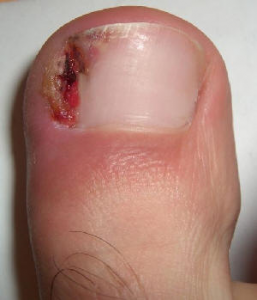
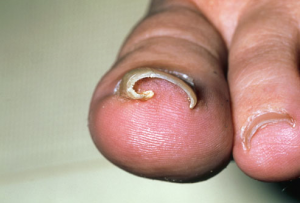
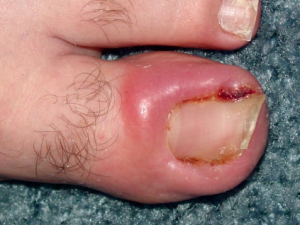
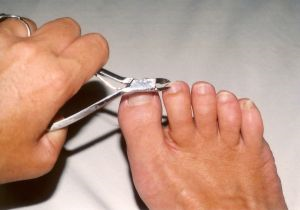
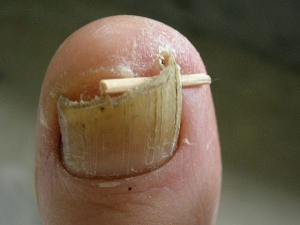
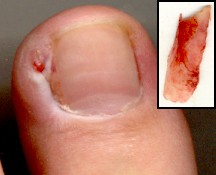
Great post – very informative. If you are beyond self treatment because an infection has started to set in then you need to book an appointment to see a podiatrist as soon as possible. In the case of a minor infection your podiatrist may be able to prescribe some antibiotics and bandage the toe properly so that the toenail is not pressing on the skin. However if the toenail is causing extreme pain and the swelling and infection are really bad, the doctor may have to perform surgery on the toe to remedy the situation. This could mean having some or all of the toenail or surrounding skin cut and removed.
I have found your aticle very helpfull, for some months i didnt know what was wrong with my big foot toe. Until last monday i under went through surgery to remove the nail
For those who cannot (or prefer not to) go to a professional, if you have an antibiotic capsule such as Amoxycillin in your medicine cabinet, you can open it up and tap a little of the powder onto the infection. Repeat a few times a few hours apart and you’ll probably not even use up the capsule’s contents, but your infection should reduce sufficiently for the pain to diminish, allowing standard toenail care treatment to take over.
Crush up an aspirin,and mix it with Vaseline.
Put it on the ingrown toenail put a sock over it to hold the medicine in place.
Most times it will be better in the morning,if not do it one more night and it will get well.
The aspirin and Vaseline softens the hard core of the in grown nail and relives the pain permanently.
It’s just an old time treatment,but it works almost every time: